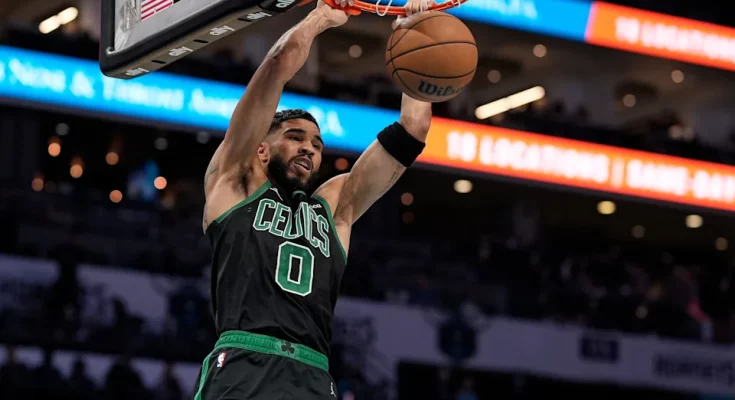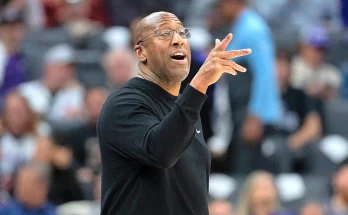Jayson Tatum has emerged as one of the most electrifying talents in the NBA over the past several years, and as the Boston Celtics continue to pursue championship glory, the conversation around his long-term impact on the league has intensified. At just 26 years old in 2025, Tatum is already a multiple-time All-Star, an Olympic gold medalist, and a consistent contender in discussions about the league’s elite players. His combination of size, skill, and scoring ability makes him a rare talent who can dominate in multiple facets of the game. Yet as fans and analysts speculate about the NBA landscape five years down the line, a compelling question arises: could Jayson Tatum cement himself as the best player in the NBA by 2030 and define a new era of basketball?
To explore this question, it is essential to understand Tatum’s skill set and the trajectory of his career. From the moment he entered the league as the third overall pick in the 2017 NBA Draft, Tatum demonstrated an uncommon poise and scoring ability for a teenager. In his rookie season, he showed flashes of the versatile scoring ability that would later become his trademark. Over the following years, he refined his mid-range and three-point shooting, developed a more consistent defensive presence, and improved his leadership on a team that has increasingly relied on him as a primary option. Today, Tatum’s offensive game is nearly unstoppable at times. He combines a smooth jump shot, powerful drives to the basket, and the ability to score in isolation situations against the league’s best defenders. Beyond his scoring, he has steadily improved his playmaking, rebounding, and defensive awareness, making him a more complete player with each passing season.
While Tatum’s individual skills are impressive, being the best player in the NBA requires more than just personal talent. Legacy, team success, and the ability to consistently perform in high-stakes situations are equally critical. In this regard, Tatum has already made significant strides. He has been a central figure in multiple deep playoff runs with the Celtics, including appearances in the Eastern Conference Finals and the NBA Finals. These experiences have not only honed his competitive instincts but also positioned him as a player capable of carrying a franchise through the most challenging stages of competition. His clutch performances in playoff games, often against elite defenders and under immense pressure, suggest a player with the mental fortitude required to reach the pinnacle of the league.
Looking toward 2030, several factors could influence Tatum’s trajectory. First, his physical health and durability will be crucial. Tatum has so far avoided major injuries, a testament to his conditioning and commitment to his body, but the wear and tear of an NBA career can accumulate over time. If he maintains his health, it is reasonable to expect him to remain an elite player into his early 30s, a period in which many superstars enter their peak performance years. Second, the evolution of his game will play a role. Tatum has consistently added new dimensions to his skill set, from improving his three-point shooting to enhancing his defensive versatility. By 2030, if he continues this trajectory, he could evolve into one of the most complete players in league history, capable of impacting the game in virtually every way.
Another factor in assessing Tatum’s potential to be the best player by 2030 is the competitive landscape of the NBA. The league is constantly evolving, with new stars emerging each year and established players aging or declining. By 2030, players like Luka Dončić, Zion Williamson, and Victor Wembanyama may still be in their primes or at least highly effective, presenting formidable competition. Additionally, the league is expected to continue attracting international talent and nurturing homegrown prospects, further intensifying the competition at the top. Tatum’s ability to remain the premier player will depend not only on his personal development but also on how he adapts to changes in the league and maintains his edge over younger competitors.
Leadership and influence are also critical components of being considered the best player in the NBA. Tatum has already begun to establish himself as a leader both on and off the court. His work ethic, professionalism, and willingness to take responsibility in key moments have earned him the respect of teammates and coaches alike. By 2030, if he continues to build on this foundation, he could be seen not just as a phenomenal scorer but also as the emotional and strategic anchor of a championship-caliber team. This leadership aspect often separates great players from all-time legends, and Tatum has shown the capacity to grow in this dimension.
A championship pedigree will be a decisive factor in determining Tatum’s standing in 2030. While individual accolades such as All-NBA selections and scoring titles are important, the NBA has historically placed the highest value on players who can deliver rings. The Celtics are already positioned as a perennial contender, and Tatum’s performance in these high-pressure environments will likely shape public perception and historical evaluation. If he can lead Boston to multiple championships over the next several years, it would solidify his claim to being the league’s best player in a way that numbers alone cannot.
It is also worth considering the intangibles that make a player legendary. Tatum possesses a rare combination of grace, confidence, and competitive fire. He has a calmness in critical moments that contrasts with the intensity of the game, allowing him to perform at an elite level under pressure. Fans and analysts alike have noted his ability to seemingly elevate his performance in crucial situations, a hallmark of players who define eras. By 2030, these intangibles, combined with sustained excellence, could elevate him above other talented contemporaries and establish him as the defining figure of his generation.
Of course, predicting the NBA’s landscape five years in advance is inherently uncertain. Injuries, team changes, and shifts in playing style can dramatically alter a player’s trajectory. Nevertheless, current trends and Tatum’s demonstrated growth suggest that he is on a path consistent with those who have dominated the league in their prime. If he continues to refine his game, maintain his health, and lead the Celtics to championship contention, the argument for him as the NBA’s best player by 2030 will be compelling.
In conclusion, Jayson Tatum’s potential to become the best player in the NBA by 2030 is not merely speculative—it is grounded in his skill set, accomplishments, leadership qualities, and trajectory of improvement. He combines scoring, playmaking, defense, and mental toughness in a way few players do at such a young age. His ability to perform in high-stakes games, adapt to the evolving league, and maintain his physical prime positions him as a frontrunner to define the NBA in the latter half of the decade. While the competition will be fierce, Tatum’s blend of talent, drive, and strategic growth makes the possibility of him reigning as the league’s top player not just a dream but a plausible reality. By 2030, basketball fans may well look back at Tatum as the player who not only carried the Celtics but also reshaped the landscape of the NBA, ushering in a new era of elite, versatile, and unstoppable talent.


